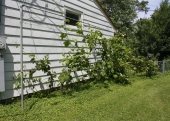








 1
1




scott romack wrote:Also, I just saw Silvopasture http://www.youtube.com/watch?v=VJsKmBbtw7Q&list=WLEED29AA267D69FAA which looks close to what I am thinking.
Anybody know anything about silvopasture?
I may split it into another thread?
Agricultural Insights Daily Podcast/Blog about Sustainable Agriculture with a focus on livestock and grazing.
The Grazing Book




scott romack wrote:Also, I just saw Silvopasture http://www.youtube.com/watch?v=VJsKmBbtw7Q&list=WLEED29AA267D69FAA which looks close to what I am thinking.
Anybody know anything about silvopasture?
I may split it into another thread?
LM McWilliams
Farside Farm, New England








Please check me out. http://www.dandeliondreamspermaculture.com
http://www.dandeliondreamsfarm.com
 1
1












Zone 5/6
Annual rainfall: 40 inches / 1016 mm
Kansas City area discussion going on here: https://www.facebook.com/groups/1707573296152799/




Zone 5/6
Annual rainfall: 40 inches / 1016 mm
Kansas City area discussion going on here: https://www.facebook.com/groups/1707573296152799/
 1
1




 1
1




Permaculture and Homestead Blogging on the Traditional Catholic Homestead in Idaho! Jump to popular topics here: Propagating Morels!, Continuous Brew Kombucha!, and The Perfect Homestead Cow!





 1
1




Permaculture and Homestead Blogging on the Traditional Catholic Homestead in Idaho! Jump to popular topics here: Propagating Morels!, Continuous Brew Kombucha!, and The Perfect Homestead Cow!









